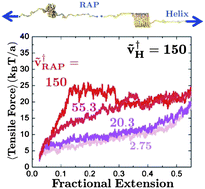Understanding how properties of complex, sequenced (bio)macromolecules derive from structural components is currently a dynamic field of research, and is one that has incredible potential to provide principles governing the development of novel materials with improved or tailored properties. Here, we explore the mechanical response of single self-associating polymers using a combination of simulation and theory, and articulate how they could be used as fundamental “units” in material design. In particular, we study chains with two different structural motifs: a randomly arranged polymer globule and a polymer arranged in a helical structure, both of which appear in biological systems. Our results show that by tuning the self-association characteristics (e.g. binding time scales) and the particular structural motifs one can precisely tailor the mechanical response of such chains. Furthermore, we demonstrate that by coupling multiple units it is possible to “design” de-novo systems that exhibit novel and predictable force-extension behavior. Our results have important consequences for understanding many biological systems, as well as for designing synthetic materials with prescribed mechanical characteristics.

You have access to this article
 Please wait while we load your content...
Something went wrong. Try again?
Please wait while we load your content...
Something went wrong. Try again?


 Please wait while we load your content...
Please wait while we load your content...